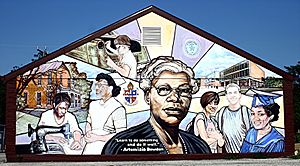Artemisia Bowden facts for kids
Artemisia Bowden (born January 1, 1879 – died August 18, 1969) was an amazing African American school leader and a civil rights activist. She is best known for her important work in starting and running St. Philip's College in San Antonio, Texas.
Her Early Life
Artemisia Bowden was born in Albany, Georgia. Her parents, Milas and Mary Bowden, had been slaves. She grew up in Brunswick, Georgia. Artemisia went to Athanasius’ parish school because her father was active in their church. Later, she studied at St. Augustine's Normal School in Raleigh, North Carolina, and graduated in 1900.
Her Life and Work
Artemisia was the oldest of four children. When she was young, she learned important skills like cooking, sewing, and playing the piano. She never married, but people often said she was "married" to her school and her duty to help others. She was known for being very confident. One person described her as someone who felt she could "overcome any obstacle."
Artemisia spent much of her life working hard for equal education and rights for African Americans. For example, she helped create a nursing unit for Black nurses at Robert E. Green Hospital. She also helped get Lindbergh Park for Black residents and started the East Side Settlement House. In 1935, she earned her bachelor's degree from St. Augustine's College. She also received an honorary degree from Wiley College for all her efforts in Texas.
Her Career in Education
After graduating in 1900, Artemisia Bowden became a teacher at St. Joseph's Parochial School in Fayetteville, North Carolina. After one year, she moved to High Point Normal and Industrial School in High Point, North Carolina. She taught there for another year.
In 1902, Bishop James Johnston was looking for a skilled person to lead and teach at St. Philip's Normal and Industrial School in San Antonio, Texas. Artemisia Bowden took the job and became the principal. She made many important changes to St. Philip's Day School.
Under her leadership, the school was divided into different sections: a primary and secondary grammar school, and a vocational school. In the vocational program, she taught young women reading, writing, math, history, botany, sewing, cooking, and other home skills.
Around 1907, public schools started offering vocational and industrial skills. Because St. Philip's tuition was high, fewer students enrolled. Artemisia worked hard to find students from outside San Antonio. She also added a Normal Department to train elementary school teachers. By 1908, low enrollment was no longer a problem. In 1917, she helped move the school to its current location on the East Side of San Antonio.
In 1926, Artemisia Bowden worked to help St. Philip's become a junior college. She raised money, and with help from the American Church Institute for Negroes, the school got a new main building. This building had classrooms, dorms for students, a gym, music rooms, a dining hall, a craft room, and a library. St. Philip's Junior College opened in September 1927.
During the Great Depression in 1934, the Episcopal Church stopped supporting St. Philip's financially. This meant the school faced serious money problems. Artemisia used $1,000 from her own inheritance to pay for school supplies and teacher salaries. She also tried to get the San Antonio School Board to take over the school's costs. After being turned down several times, her efforts paid off. On September 15, 1942, St. Philip's Junior College was accepted by the San Antonio School Board. It became the first junior college for Black students to be run by a city school board. Artemisia Bowden became its Vice President. In 1954, after 52 years of service, Artemisia Bowden retired. She was given the special title of Dean Emeritus.
Her Lasting Legacy
Artemisia Bowden passed away on August 18, 1969, in San Antonio. She is remembered not only for making St. Philip's College a success but also for her leadership in helping African Americans in San Antonio.
She received honorary degrees from Wiley College in 1935 and Tillotson College in 1952 for her community work. She led the San Antonio Metropolitan Council of Negro Women and founded the Negro Business and Professional Women's Club. In 1955, the Zeta Phi Beta sorority named her "Woman of the Year." The National Council of Negro Women also honored her as "one of the ten most outstanding women educators in the United States."
Artemisia Bowden's legacy continues today. Bowden Elementary School, the Bowden Administration Building at St. Philip's College, and the University of Incarnate Word's Health and Eye Center are all named after her. In 2015, she was recognized as a saint in the Episcopal Church, with August 18 as her saint day.
See Also


